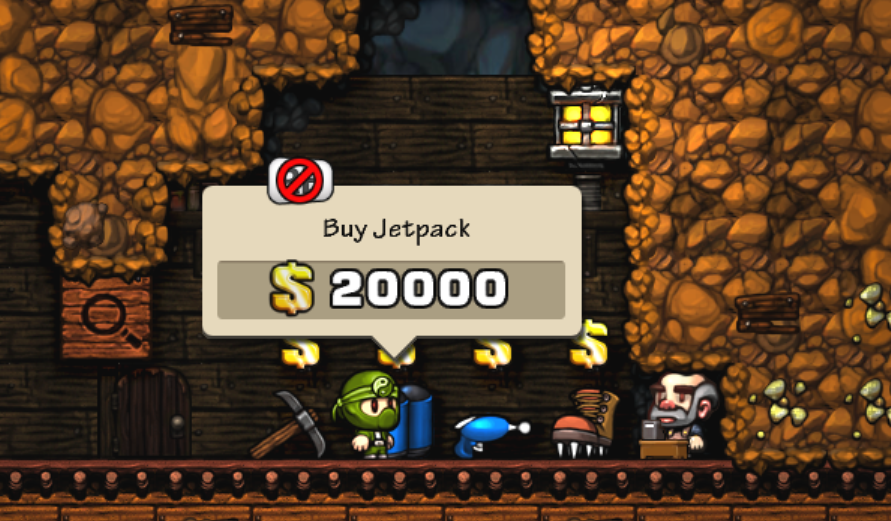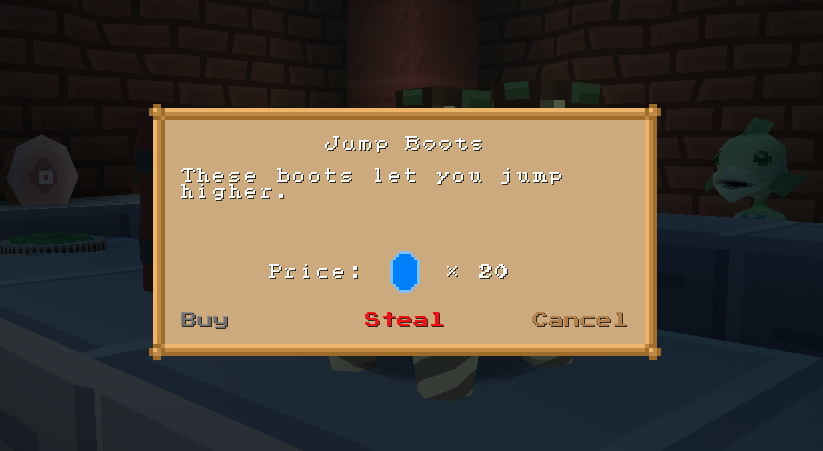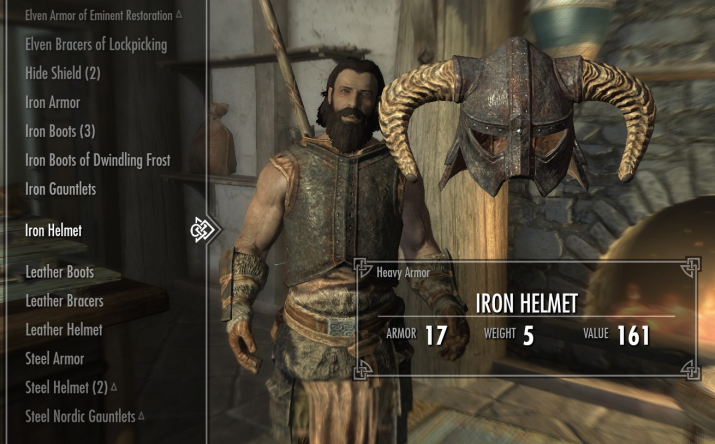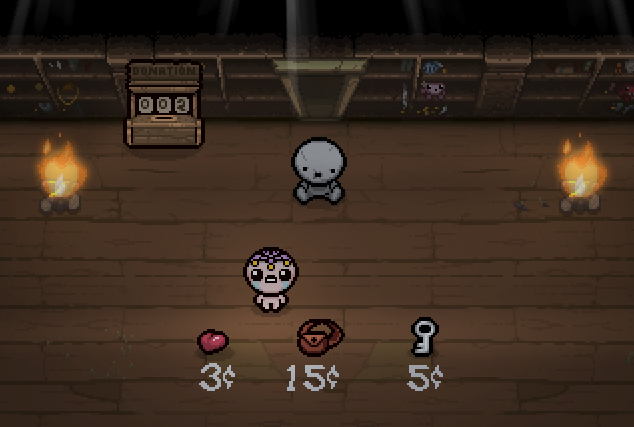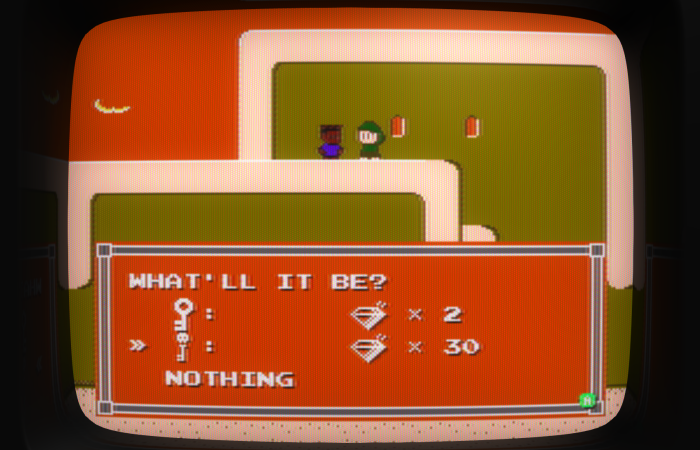I’ve been playing a bunch of roguelikes recently — as one does when one is making a roguelike — looking for interesting elements to deconstruct and possibly adapt for Gunmetal Arcadia. Today I’ll be talking about shops and shoplifting.
Item shops are a staple of RPG and adventure games, and roguelikes are no exception. The opportunity to exchange currency for new abilities, upgrades, or other resources can offer the player a number of interesting choices. An item shop should present the player with a multitude of potential upgrade paths. In a typical situation, assuming a well-balanced economy, the player should not feel that they can afford everything for sale, as that would not be an interesting choice. There are exceptions, of course; the player may not have collected any money prior to visiting a shop early in the game, or they may choose to amass a fortune before spending anything. But in the general case, we want to feel like we can choose at most one, maybe two of the items available. In essence, we are making a bet based on the information available that these items will improve our chances over the course of the run.
In being presented multiple options, we have a choice to make, but a more subtle benefit is that we have tangible evidence that the remainder of the session could take a different form depending on this choice. This gets to the core of what makes roguelikes appealing to me, and it is vastly preferable to leaving the shape of the session entirely in the hands of the random number generator or hidden knowledge, although those can have their places too.
Seeing items you can’t afford may be frustrating for beginners who want to experiment with every possible option right off the bat, but there are benefits to this experience as well. It offers a glimpse of future opportunities, the proverbial carrot to permadeath’s stick. It also imparts value to the in-game currency. Shiny money pickups may be fun and moderately compelling to collect on their own merits, but if we find that we always have enough cash to buy everything in stock, then these pickups are rendered useless.
That’s my rough baseline for what I would expect an item shop to be, and practically every example I can find meets these goals. Things get more interesting when we look at the interactions involved in the shopping experience and the alternate paths these afford the player. I’ll be looking at a few cases from recent games, not all of them roguelikes, as I home in on the appropriate interface for Gunmetal Arcadia.
In Spelunky, shop inventory is present in the world. It can be picked up and carried just like any object in the game. Doing so will prompt the shopkeeper to approach the player, and if the item is carried out of the store, the shopkeeper will become aggressive.
These shops are intuitive and well integrated with the rest of the game. They reuse familiar controls and don’t interrupt gameplay with a modal menu. Using the RB button to purchase items is a little strange insofar as it is also the button used to enter doors, but as these actions can never occur simultaneously, there is little chance of confusion.
This implementation is thoughtful in that it makes accidental theft difficult. The button prompt encourages a purchase, and shoplifting is not clearly made an option. In order to steal an item, the player must choose to deliberately pick it up and carry it outside the shop, ignoring the shopkeeper’s attracted attention.
The player may also choose to kill the shopkeeper, in which case the items will no longer be purchasable but may simply be collected as if they had been encountered outside a shop. Any aggressive action towards the shopkeeper will instantly make him hostile, however, and as all shopkeepers are armed with shotguns, they are dangerous foes. Whether by design or coincidence, it is also easy to accidentally anger shopkeepers, e.g., by detonating bombs near a shop or by allowing a shopkeeper to be injured by another enemy’s attacks.
Shops in Eldritch were largely modeled after those in Spelunky. A lone shopkeeper oversees his inventory, which may be bought or stolen. These items do not behave exactly the same as others in the world, however. Ordinarily, items may be collected with a single button press. Within shops, interacting with items will instead launch a modal menu prompting the player to buy or steal the item.
It’s interesting to note that the game pauses while this menu is open, but the interruption is minimal. All shops in Eldritch are placed behind closed doors, so they tend to feel like safe spaces, isolated from the hostile outside environment.
Although not roguelikes, I want to bring up the Elder Scrolls games because they have an interesting and unusual implementation of shops and shoplifting. Stores are manned by shopkeepers who serve as the interface for making purchases. This is done through a modal menu which does not have an option for theft. What is particularly interesting is that some, but not all, of a store’s inventory is also reflected in the environment. These items can be stolen, and the normal “Take” prompt becomes “Steal,” written in red letters to indicate that it will draw the ire of onlookers.
These in-world items are linked to the entries in the shopkeeper’s menu; purchasing an item from the menu will remove its representation from the world if it has one. However, some items in the world do not correspond to menu entries. These may be stolen, but they cannot be legitimately purchased. These tend to be decorative items like cups and plates that serve no functional purpose but still have some small monetary value.
The Binding of Isaac does not have a shoplifting feature, but it is worth mentioning here because its shops have some other merits that could be relevant to Gunmetal Arcadia. Shops in Isaac are safe spaces. They do not contain enemies, and although a statue is present as a sort of symbolic shopkeeper, it serves little functional purpose. As with all items in Isaac, shop items may be picked up by walking over them. If the player can’t afford the iteam, it simply remains on the ground.
Every shop is found behind a locked door, and the majority of locked doors lead to shops. However, some locked doors lead to a mini-boss fight instead. Therefore, making the decision to spend a key unlocking a door serves as a risk-reward gamble. Pricing also comes into play here. As keys may be rare in the early game and throughout, the decision to unlock a shop is often made based on how much money the player is carrying. Shops will always contain a major item priced at 15 cents, but there is a chance it will be marked down by 50%, so it is sometimes worth entering a shop even without the requisite 15 cents.
New to the Rebirth remake of The Binding of Isaac is a donation box that appears within shops. Money donated to this box persists across sessions (a notable exception to the rule in this game) and can unlock additional features once it has collected enough coins. It can also dispense coins if a bomb is detonated next to it. The offers a little more flexibility in play without completely upending the sense that every run is viable.
Finally, shopping in my own Super Win the Game occurs entirely within menus, with no ability to steal. I bring this up not because it is particularly interesting or relevant to the discussion of shops and shoplifting, but because, as the technological predecessor to Gunmetal Arcadia, it represents the path of least resistance in what I could choose to implement for that game.
There are things I love about all of these implementations, and it’s easy to imagine that bits and pieces of any of them could find their way into Gunmetal. At the moment, I’m imagining shops to be single-screen rooms branching off from the critical path. I like the idea that every door in the background is a gamble. Maybe it leads to a tech shop with an assortment of shiny implants to make you run faster and jump higher. Or maybe it leads to a pit of dire wyrmvipers that want to eat your face.
For as much as I’ve talked about it here, I don’t yet know for sure whether Gunmetal Arcadia will actually support shoplifting at all. One of my goals with this game is to follow the mantra of “say yes to the player,” and in that regard, it feels like an obvious win. But I suspect whether it makes the cut and what form it takes will depend in large part on how the economy is balanced (i.e., does shoplifting feel worth the risk?), what sort of persistent narrative elements exist (how will the bad karma affect future runs?), and so on.
I should be back to normal development this week, so next week’s blog will probably be a big long technical rant about entity refactoring or somesuch. We’ll see.

